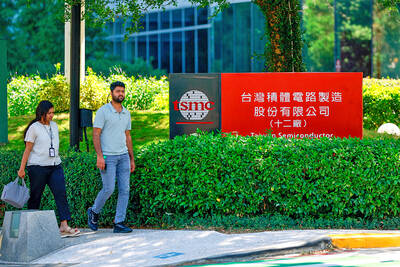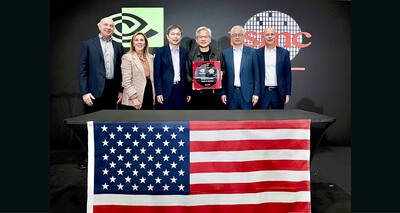Advanced Micro Devices Inc (AMD) has applied to set up a research and development (R&D) center in Taiwan as part of the government’s “A+ Industrial Innovative R&D Program,” the Ministry of Economic Affairs said yesterday.
The ministry did not disclose the investment amount or what the plan is.
The program covers three major fields — artificial intelligence (AI), new generation semiconductors, including high-power and high-frequency integrated circuits (ICs), and new 5G network structures.

Photo: Dado Ruvic, Reuters
It aims to encourage local and foreign technology firms to invest in Taiwan and for the nation to become a global R&D hub, the Executive Yuan said.
A qualified applicant would receive a subsidy worth up to 50 percent of its investment.
AMD is planning to invest about NT$5 billion (US$155 million) and the ministry has given the company conditions that must be met to receive the subsidy, local media reported, citing an unnamed government source.
AMD was to work with Taiwanese IC designers to develop the domestic IC industry, the source said, adding that the servers which use its AI chips would also be produced in Taiwan.
The ministry also required AMD to recruit enough foreign talent to account for at least 20 percent of its R&D workforce in Taiwan, so that the tech giant would not have to compete with Taiwanese firms for local talent, the source said.
The source said that the ministry wanted AMD to work with Taiwanese universities to help cultivate talent.
AMD has responded positively to the ministry’s conditions, the source added.
AMD CEO Lisa Su (蘇姿丰) is scheduled to attend the Computex Taipei trade show early next month and is expected to discuss R&D plans with the administration of President William Lai (賴清德), who was sworn yesterday, local media reports said.
The ministry has approved several investment applications filed by several tech heavyweights wanting to invest in Taiwan under the program.
Investors include Netherlands-based semiconductor equipment supplier ASML Holding NV, US wafer fabrication equipment supplier Lam Research Corp and US semiconductor equipment supplier Applied Materials Inc.
In 2021, US chip giant Nvidia Corp secured approval for its investment plan under the “Supreme A+ Program.”
The AI innovation and R&D center program, which began in 2020, aims to attract innovators to invest in state-of-the-art technologies relating to semiconductors, communications and AI in Taiwan.
Nvidia’s investment plan aimed to set up an AI R&D center through a NT$24.3 billion investment, with the ministry providing a subsidy worth NT$6.7 billion. The company is to cooperate with enterprises and universities through its investments.

RECYCLE: Taiwan would aid manufacturers in refining rare earths from discarded appliances, which would fit the nation’s circular economy goals, minister Kung said Taiwan would work with the US and Japan on a proposed cooperation initiative in response to Beijing’s newly announced rare earth export curbs, Minister of Economic Affairs Kung Ming-hsin (龔明鑫) said yesterday. China last week announced new restrictions requiring companies to obtain export licenses if their products contain more than 0.1 percent of Chinese-origin rare earths by value. US Secretary of the Treasury Scott Bessent on Wednesday responded by saying that Beijing was “unreliable” in its rare earths exports, adding that the US would “neither be commanded, nor controlled” by China, several media outlets reported. Japanese Minister of Finance Katsunobu Kato yesterday also

China Airlines Ltd (CAL, 中華航空) said it expects peak season effects in the fourth quarter to continue to boost demand for passenger flights and cargo services, after reporting its second-highest-ever September sales on Monday. The carrier said it posted NT$15.88 billion (US$517 million) in consolidated sales last month, trailing only September last year’s NT$16.01 billion. Last month, CAL generated NT$8.77 billion from its passenger flights and NT$5.37 billion from cargo services, it said. In the first nine months of this year, the carrier posted NT$154.93 billion in cumulative sales, up 2.62 percent from a year earlier, marking the second-highest level for the January-September

‘DRAMATIC AND POSITIVE’: AI growth would be better than it previously forecast and would stay robust even if the Chinese market became inaccessible for customers, it said Taiwan Semiconductor Manufacturing Co (TSMC, 台積電) yesterday raised its full-year revenue growth outlook after posting record profit for last quarter, despite growing market concern about an artificial intelligence (AI) bubble. The company said it expects revenue to expand about 35 percent year-on-year, driven mainly by faster-than-expected demand for leading-edge chips for AI applications. The world’s biggest contract chipmaker in July projected that revenue this year would expand about 30 percent in US dollar terms. The company also slightly hiked its capital expenditure for this year to US$40 billion to US$42 billion, compared with US$38 billion to US$42 billion it set previously. “AI demand actually

Jensen Huang (黃仁勳), founder and CEO of US-based artificial intelligence chip designer Nvidia Corp and Taiwan Semiconductor Manufacturing Co (TSMC, 台積電) on Friday celebrated the first Nvidia Blackwell wafer produced on US soil. Huang visited TSMC’s advanced wafer fab in the US state of Arizona and joined the Taiwanese chipmaker’s executives to witness the efforts to “build the infrastructure that powers the world’s AI factories, right here in America,” Nvidia said in a statement. At the event, Huang joined Y.L. Wang (王英郎), vice president of operations at TSMC, in signing their names on the Blackwell wafer to